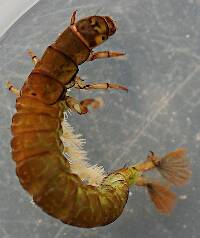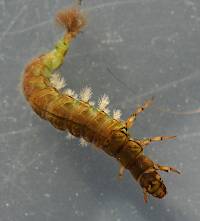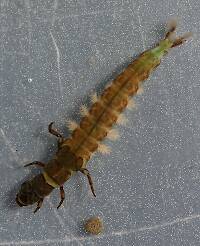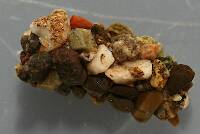
Salmonflies
Pteronarcys californica
The giant Salmonflies of the Western mountains are legendary for their proclivity to elicit consistent dry-fly action and ferocious strikes.
Featured on the forum

With a bit of help from the microscope, this specimen keys clearly and unsurprisingly to Hydropsyche.

Troutnut is a project started in 2003 by salmonid ecologist Jason "Troutnut" Neuswanger to help anglers and
fly tyers unabashedly embrace the entomological side of the sport. Learn more about Troutnut or
support the project for an enhanced experience here.
Blackghost
Posts: 3
Posts: 3
Blackghost on Apr 30, 2009April 30th, 2009, 4:24 am EDT
will the goldribbed hares ear be considered a fly that could imitate a caddis larva and stone fly in a variety of colors.
LittleJ on Apr 30, 2009April 30th, 2009, 6:10 am EDT
The hares ear can imitate a lot of things, however I doubt that it will do well w/ either that you mention. I use it primarily as a generic mayfly, usually for march brown,cahill type clinger nymphs.
jeff
jeff
CaseyP on Apr 30, 2009April 30th, 2009, 1:11 pm EDT
Blackghost,
welcome! you've come to the right place to learn about the bugs, and the folks on the forum are pretty good at helping you choose a pattern to imitate what you need to. then you can google the pattern if you need tying directions.
caddis larvae are usually little worm-shaped things that live in tubes, so their fly patterns don't have wing cases or ribbing or tails. instead, think of a suitably colored dubbing that would match the stream bottom on a straight nymph hook, with a bit of bright green or tan or yellowish at one end to represent the head peeking out. or just the green worm itself tied on a curved hook. there is a famous pattern called the Green Weenie which will catch trout (though some purists don't admit to using it!)
stone fly nymphs are much more complicated with wing case arrangements and legs and all. they are, i think, larger than your average GRHE.
as LittleJ points out, your GRHE is great for mayfly nymphs, like the sulphur and March Brown, which will be busy hatching in Pennsylvania in the next few weeks. you don't mention where you're fishing, but i think those bugs are pretty common.
welcome! you've come to the right place to learn about the bugs, and the folks on the forum are pretty good at helping you choose a pattern to imitate what you need to. then you can google the pattern if you need tying directions.
caddis larvae are usually little worm-shaped things that live in tubes, so their fly patterns don't have wing cases or ribbing or tails. instead, think of a suitably colored dubbing that would match the stream bottom on a straight nymph hook, with a bit of bright green or tan or yellowish at one end to represent the head peeking out. or just the green worm itself tied on a curved hook. there is a famous pattern called the Green Weenie which will catch trout (though some purists don't admit to using it!)
stone fly nymphs are much more complicated with wing case arrangements and legs and all. they are, i think, larger than your average GRHE.
as LittleJ points out, your GRHE is great for mayfly nymphs, like the sulphur and March Brown, which will be busy hatching in Pennsylvania in the next few weeks. you don't mention where you're fishing, but i think those bugs are pretty common.
"You can observe a lot by watching." Yogi Berra
Patcrisci on May 1, 2009May 1st, 2009, 3:01 am EDT
when trout are on nymphs, the GRHE in one of three shades (mottled fur dubbing of tan/gray/brown) in either light, medium, or dark, will take fish. The key is having the right size and putting the fly where it will do business. Sometimes that's on the stream bottom, or near the surface of the water, or somewhere in between. This fly in any of its many varieties, fished where the fish are looking for it, will take trout year round. In bigger sizes, weighted, it makes a passable stonefly imitation too. If you want to imitate a caddis try a GRHE wet fly.
Pat Crisci
Quick Reply
Related Discussions
Topic
Replies
Last Reply
0
May 6, 2011
by Jtberez
by Jtberez
17
Nov 22, 2014
by Millcreek
by Millcreek








